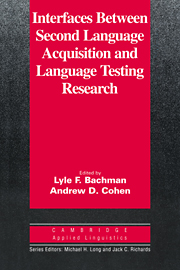Book contents
- Frontmatter
- Contents
- List of contributors
- Series editors' preface
- Preface
- Chapter 1 Language testing – SLA interfaces: An update
- Chapter 2 Construct definition and validity inquiry in SLA research
- Chapter 3 Research on interlanguage variation: Implications for language testing
- Chapter 4 Strategies and processes in test taking and SLA
- Chapter 5 Describing language development? Rating scales and SLA
- Chapter 6 Testing methods in context-based second language research
- Chapter 7 How can language testing and SLA benefit from each other? The case of discourse
- Appendix: Language testing – SLA research interfaces
- Index
Appendix: Language testing – SLA research interfaces
Published online by Cambridge University Press: 05 October 2012
- Frontmatter
- Contents
- List of contributors
- Series editors' preface
- Preface
- Chapter 1 Language testing – SLA interfaces: An update
- Chapter 2 Construct definition and validity inquiry in SLA research
- Chapter 3 Research on interlanguage variation: Implications for language testing
- Chapter 4 Strategies and processes in test taking and SLA
- Chapter 5 Describing language development? Rating scales and SLA
- Chapter 6 Testing methods in context-based second language research
- Chapter 7 How can language testing and SLA benefit from each other? The case of discourse
- Appendix: Language testing – SLA research interfaces
- Index
Summary
Introduction
Language testing [LT] research and second language acquisition [SLA] research are often seen as distinct areas of inquiry in applied linguistics. To oversimplify slightly, SLA research takes a longitudinal view, concerning itself primarily with the description and explanation of how second language proficiency develops, while LT research typically observes a “slice of life,” and attempts to arrive at a more or less static description of language proficiency at a given stage of development. While LT research has tended to focus on the complexities of the language proficiency that are the result of acquisition, SLA research has concerned itself more with the factors and processes that affect or are part of acquisition. That is, SLA research has tended to focus on the antecedents of proficiency, without concerning itself unduly with the complexity of that construct, while LT research has investigated the results of acquisition, largely ignoring questions of how proficiency develops. Finally, LT and SLA research have lent themselves to different research methodologies: SLA research has historically utilized the linguistic analysis of learners' interlanguage utterances, descriptive case studies, experimental and quasi-experimental designs, and ethnographic research, while LT research has more typically employed ex post facto, correlational methods.
In recent years LT researchers have probed the nature of language proficiency, not only to develop more useful measures of it, but also to better understand its complexity. One result of this research has been the emergence of a general consensus that language proficiency consists of a number of distinct but related component abilities.
- Type
- Chapter
- Information
- Publisher: Cambridge University PressPrint publication year: 1999
- 1
- Cited by



